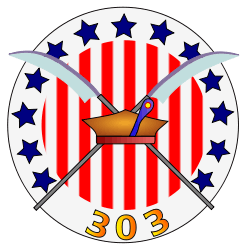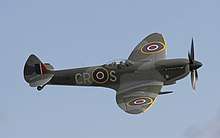Tadeusz Arentowicz
Tadeusz Arentowicz (1909-1941) was a Polish fighter pilot and ace during the Second World War. He served as a flight Lieutenant in the Royal Air Force in the No. 303 Polish Fighter Squadron (Polish: 303 Dywizjon Myśliwski "Warszawski im. Tadeusza Kościuszki"}. He was B-group Flight Commander of the squadron.[1][2][3] A week after his final promotion, in 1941, he was on a mission escorting bombers when his plane was shot down by a German fighter near Dunkirk over the English Channel; he was never found.[4]
Tadeusz Arentowicz | |
|---|---|
 Tadeusz Arentowicz during WWII | |
| Nickname(s) | "Szpak" ('Starling' in English) |
| Born | 19 September 1909 Sierpc, Russian Empire |
| Died | 8 July 1941 (aged 31) Somewhere off of Dunkirk. |
| Allegiance | |
| Service/ | |
| Years of service | 1933–1941 |
| Rank | Flight lieutenant |
| Service number | P-0251 |
| Unit |
|
| Commands held | 303 Squadron (1941) |
| Battles/wars | |
| Awards |
|
Military career

Tadeusz Arentowicz was a graduate of the Polish Air Force University in Deblin (VII Promotion[5]). On the fifteenth of August 1933 he was given the rank of second lieutenant in the Polish Air Force and was assigned to the 1st Air Regiment stationed in Warsaw. He would finish his training in Grudziądz. He would become an instructor at the Ułęż airport near Deblin on March 1939.[6] See No. 315 Polish Fighter Squadron.
He participated in the September Campaign as a member of the Deblin Group. He had evacuated to Romania from the Wielick airport with other pilots. He would then wait to be picked up by the English at Port of Constanța. The English transports had never arrived to pick him and the others up. He would then manage to make his way to France and proceed on to England.
He would receive his service number of P-0251 in 1941. After he was trained to use British equipment he would be assigned to the 303rd Polish Fighter Squadron.[7] He would fulfill the duties of squadron leader after the death of Zdzisław Henneberg and would come to be the command of the whole squadron on 3 July 1941.[8]
He joined 303 after the Battle of Britain. His career is enigmatic, as little is known; but he was known by the nickname, "Szpak" ('Starling' in English). Although he started as a flight lieutenant, death (Zdzisław Henneberg) and injury (Wacław Łapkowski) of his predecessors created a vacancy, and he was elevated to Flight Commander.[4]
On 3 March 1941, after the Squadron had been upgraded to Spitfire Mk IIA planes, Arentowich led attacked the German airfield at Le Touquet, another at Waben, and strafed an army transport depot at Breck-sur-Mer.[9]
On 16 April 1941, Arentowich had become the acting Commanding Office. He presented a nomination of Waclaw Lapkowski (a second time) for the Cross of Valor.[10]
On 11 March 1941, he and two other pilots were vectored in by ground control to attack an aircraft at 10,000 feet. This incident came to be called "A Little Mistake" in the squadron's log. Arentowicz was part of an attack by three Polish Spitfires on a friendly Armstrong Whitworth Whitley that was involved in paratroop training. Fortunately, and despite 100 hits, the plane survived and no injuries were experienced.[1]
He was given a prominent role during at least one ceremonial occasion.[11]
He was at the helm of Spitfire II PF 8385 IMPREGNABLE and damaged a Messerschmitt Bf 109 on 25 June 1941.[12]
Death

On 8 July 1941, he flew the Supermarine Spitfire (designation P 8502) on mission to escort bombers to destroy the railway line and station in Lille. He was shot down by a German fighter and fell into the sea (the other pilots saw him fall into the sea somewhere near Dunkirk).[13] Polish forces searched for him but he was never found.[2][6][13]
He was replaced as Squadron Commander by Lieutenant Jankiewicz.[14]
He is remembered on the Polish Memorial to Aircrew in Warsaw and the Polish War Memorial near RAF Northolt.
Awards

- Field Pilot's Badge
See also
- 2018 film Hurricane: 303 Squadron
- Air Force of the Polish Army
- List of Royal Air Force aircraft squadrons
- Non-British personnel in the RAF during the Battle of Britain, emphasizing the experience of the transplanted pilots and the superiority of their tactics.
- Polish Air Forces
- Polish Air Forces in Great Britain,\
- Polish contribution to World War II
References
- Gretzyngier & Matusiak 2002, pp. 191, 194, 213-214, 248, 269.
- Zieliński & Krzystek 2002, p. 15.
- "No. 303 Polish Fighter Squadron" (PDF). p. 8.
- Knoblock 2012, p. 113-114.
- "VII promocja Szkoły Podchorążych Lotnictwa - 1933 r." www.polishairforce.pl.
- Sowa, Aneta. "ARENTOWICZ Tadeusz Aleksander". Biblioteka Główna (in Polish). Lotnicza Akademia Wojskowa. Retrieved 10 December 2019.
- Ratuszynski, Wilhelm. "The 303 Polish Fighter Pilots List". Retrieved 1 December 2019.
- Cumft & Kujawa 1989.
- Knoblock 2012, p. 59.
- Knoblock 2012, p. 64.
- The Polish Air Force in Britain, 1940-1947 "Flying Officer Tadeusz Arentowicz leading airmen of No. 303 Polish Fighter Squadron during the march past after an investiture ceremony at RAF Norholt [sic], 29 October 1941. General Władysław Sikorski can be seen saluting in the left background. Other identified individual is Flying Officer Janusz Marciniak ..." Photograph Imperial War Museum
- Gretzyngier 2013, p. 163.
- "08.07.1941 No. 303 Squadron Spitfire 11b P8502 RF-C Sq/Ldr. Tadeusz A. Arentowicz". Archive Report:Allied forces. Aircrew remembered. Retrieved 10 December 2019.
- Ratuszynski, Wilhelm. "No. 303 Polish Squadron History". polishsquadronsremembered.com. Retrieved 12 December 2019.
Bibliography
- Cumft, Olgierd; Kujawa, Hubert (1989). Polscy piloci myśliwscy polegli w latach 1940 - 1946 [Book of Polish pilots who died, died and disappeared 1939-1946]. Księga lotników polskich (in Polish). Warsaw: Wydawn. Ministerstwa Obrony Narodowej. ISBN 83-11-07329-5. Retrieved 10 December 2019.CS1 maint: ref=harv (link)
- Gretzyngier, Robert; Matusiak, Wojtek (23 August 2002). Poles in Defence of Britain: A Day-by-Day Chronology of Polish Day and Night Fighter Pilot Operations: July 1940–June 1941. London: Grub Street Publishers. pp. 191, 194, 213–214, 248, 269. ISBN 1902304543. ISBN 9781909166271.
The little-known WWII story of the Polish Air Force fliers who played a crucial role in the Battle of Britain and beyond.
CS1 maint: ref=harv (link) - Gretzyngier, Robert (20 January 2013). Polish Aces of World War 2. Bloomsbury Publishing. p. 163. ISBN 9781472800589.CS1 maint: ref=harv (link)
- Knoblock, Glenn (2012). "With Great Sacrifice and Bravery": The Career of Polish Ace Waclaw Lapkowski, 1939-41, Illustrated with Official RAF Combat Reports. World War 2 Biography Series (Fourth ed.). Bennington, Vermont: Merriam Press. pp. 59, 62, 64, 69, 110, 113–114. ISBN 1470055414. ISBN 978-1470055417.CS1 maint: ref=harv (link)
- Zieliński, Józef; Krzystek, Tadeusz (2002). Commanders of the Polish Air Force Squadrons in the West. Poznan: Redakcja Czasopism WLOP Dom Wydawniczy Bellona. p. 15. ISBN 8390900890. ISBN 9788390900896 – via Indiana University.CS1 maint: ref=harv (link)
Notes
- Supermarine Spitfire similar to the plane that Arentowicz was piloting in 1941 when he was shot down over the English Channel.[13]
Further reading
- Anders, Władysław (1949). An Army in Exile. London: MacMillan & Co.
- Caldwell, Donald. The JG26 War Diary, Vol. 1: 1939–1942. London: Grub Street, 1996. ISBN 978-1-898697-52-7.
- Cumft, Olgierd; Kujawa, Hubert (1989). Polscy piloci myśliwscy polegli w latach 1940 - 1946 [Book of Polish pilots who died, died and disappeared 1939-1946]. Księga lotników polskich (in Polish). Warsaw: Wydawn. Ministerstwa Obrony Narodowej. ISBN 83-11-07329-5. Retrieved 10 December 2019.CS1 maint: ref=harv (link)
- Cynk, Jerzy B. (1998). The Polish Air Force at War: The Official History, 1939-1943. Atglen, Pennsylvania: Schiffer Publishing. ISBN 0-7643-0559-X.
- Ken Delve, D-Day: The Air Battle, London: Arms & Armour Press, 1994, ISBN 1-85409-227-8.
- Fiedler, Arkady. Dywizjon 303 (in Polish). London: Peter Davies Ltd., 1942. (Translated as Squadron 303: The Polish Fighter Squadron with the R.A.F.. London: Peter Davies Ltd., 1942/New York: Roy Publishers, 1943. Reprint Kessinger Publishing, 2007.) New edition 303 Squadron: The Legendary Battle of Britain Fighter Squadron translated by Jarek Garliński. Los Angeles: Aquila Polonica, 2010 hard cover: ISBN 978-1-60772-004-1 Trade paperback ISBN 978-1-60772-005-8.
- Fiedler, Arkady (1942). Dywizjon 303 (in Polish). London: Peter Davies Ltd.
- Fiedler, Arkady; Garlinski, Jarek (2010) [1942]. Squadron 303: The Polish Fighter Squadron with the R.A.F. or 303 Squadron: the legendary Battle of Britain fighter squadron (Print) (Reprint ed.). London, Los Angeles, California: Peter Davies Ltd., Kessinger Publishing, Aquila Polonica. ISBN 978-1-60772-005-8.
- Gretzyngier, Robert. Polskie Skrzydła 4: Hawker Hurricane, część 1 (in Polish). Sandomierz, Poland: Stratus, 2005. ISBN 83-89450-37-2.
- Gretzyngier, Robert and Wojtek Matusiak. Polish Aces of World War 2. London: Osprey, 1998. ISBN 1-85532-726-0.
- Halley, James J. The Squadrons of the Royal Air Force & Commonwealth, 1918–1988. Tonbridge, Kent, UK: Air-Britain (Historians) Ltd., 1988. ISBN 0-85130-164-9.
- Jefford, C.G. RAF Squadrons, a Comprehensive Record of the Movement and Equipment of all RAF Squadrons and their Antecedents since 1912. Shrewsbury, UK: Airlife Publishing, 2001. ISBN 1-84037-141-2.
- King, Richard; Siwek, Grzegorz (2012). Wydawnictwo RM (ed.). Dywizjon 303 walka i codzienność [303 squadron: fight and everyday life] (in Polish). Warsaw: Wydawnictwo RM. ISBN 978-83-7243-979-6.
- Olson, Lynne; Cloud, Stanley (2003). A Question of Honor. The Kosciuszko Squadron: Forgotten Heroes of World War II. New York: Knopf. ISBN 0-375-41197-6..
- Ramsay, Winston, Ed. (1989). The Battle of Britain Then and Now, Mk V. London: Battle of Britain Prints International Ltd. ISBN 0-900913-46-0.
- Rawlings, John D.R. (1978) [1969]. Fighter Squadrons of the RAF and their Aircraft (Revised reprinted ed.). London: Macdonald & Jane's (Publishers) Ltd. ISBN 0-354-01028-X.
- Zaloga, Steven J.; Hook, Richard (1982). The Polish Army 1939-45. London: Osprey Publishing. ISBN 0-85045-417-4.
- Zamoyski, Adam (1995). The Forgotten Few: The Polish Air Force in the Second World War. New York: Hippocrene Books Inc. ISBN 0781804213. ISBN 9780781804219.[1]
External links
- "No. 303 Polish Fighter Squadron" (PDF). p. 11.